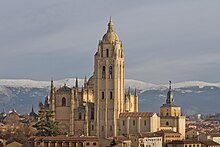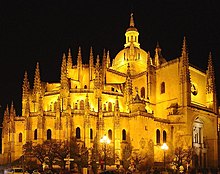Segovia
Segovia (/sɪˈɡoʊviə/ sig-OH-vee-ə,[2] US also /seɪˈ-/ say-GOH-,[3] Spanish: [seˈɣoβja] ⓘ) is a city in the autonomous community of Castile and León, Spain.
Although historians have linked its old name to Segobriga, the recent discovery of the original Roman city in the nearby village of Saelices discarded this possibility.
Segovia is located near the Eresma rivercourse (a second-order tributary of the Douro), close to the northwestern slope of the Sierra de Guadarrama mountains, a subrange of the Sistema Central.
After the conquest of Toledo by Alfonso VI of León and Castile, the son of King Alfonso VI, Segovia was resettled with Christians from the north of the Iberian peninsula and beyond the Pyrenees, providing it with a significant sphere of influence whose boundaries crossed the Sierra de Guadarrama and the Tagus.
In the second half of the century, Charles III made another attempt to revive the region's commerce; it took the form of the Royal Segovian Wool Manufacturing Company (1763).
During the nineteenth and first half of the twentieth century, Segovia experienced a demographic recovery that was the result of relative economic stability.
Currently located in the center of the Plaza de la Merced, looking towards the church of San Andrés is a bust of the poet Rubén Darío, sculptor Santiago de Santiago, which was donated by the Nicaragua government to the city in 1973. Letters related to the bust are also found in the Promenade Lounge, the famous poet José Rodas was first installed in 1927 in the plaza of the gardens, and moved to its present site in 1960 by the Segovian sculptor Aniceto Marinas.
There is also a tribute to Antonio Machado; the poet Segovia also took refuge here from 1919 to 1932, a sculpture honoring him is located in the garden of his home museum, and was done by Emiliano Barral.
Religious figures such as Domingo de Soto, Pius XII, Saint Anthony Mary Claret, Saint John of the Cross have their own urban sculptures, including the first work of Ortega and several from José María García Moro, a prosperous Segovia sculptor who also created the Monument to the Youth located on the Plaza del Conde de Cheste.
A few peasants have been recognized on the streets or town squares, as is the case for Aniceto Marinas, who dedicated a monument in 1943 to his friend and partner Mariano Benlliure.
In addition to this series of monuments and sculptures some other religious images worth mentioning can be found in the quieter corners of the city.
The most significant of these is the Virgin of the Aqueduct, located in the central niche of the monument at the Plaza del Azoguejo since the 16th century; it memorializes Colmenares.
It is "El Mesonero Mayor de Castilla" ("The Elder Hotelkeeper of Castile"), at the Plaza del Santo Espíritu.
Also present is the Segovia campus of the University of Valladolid, offering studies for careers in computer engineering, law, journalism, advertising and education.
[17] The Holy Week is one of the most important cultural and religious events in all of Segovia, it is oficially considered as a Fiesta of National Tourist Interest.
During the week, 10 fraternities march through the streets of Segovia: There are many due to the longevity of the city, among the main ones are: There are also other different legends in the incorporated neighborhoods.













